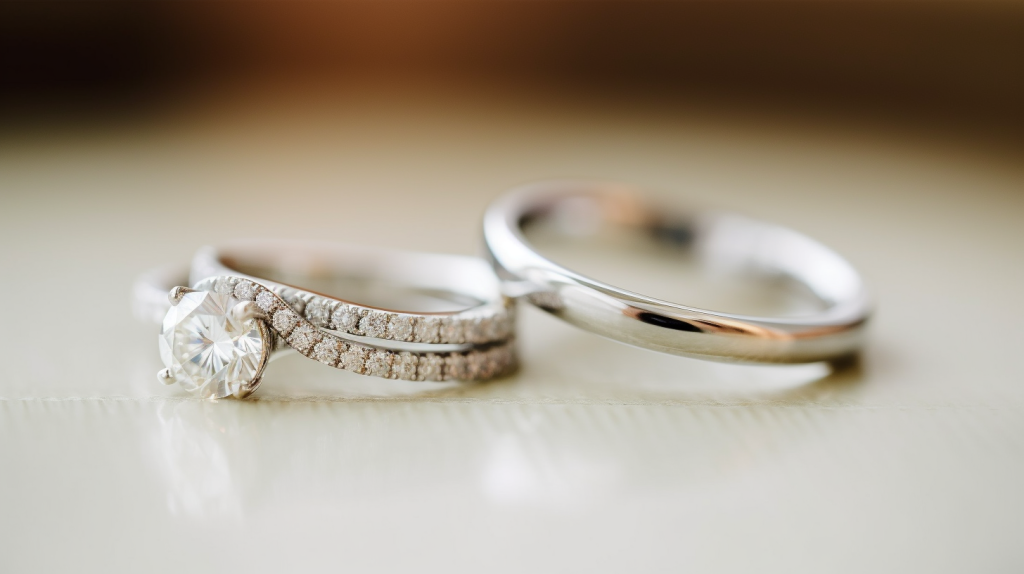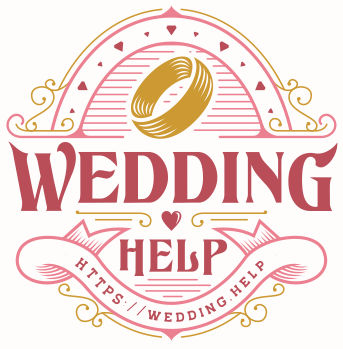The magic of getting married seems effortless: fall in love, pop the question, have a wedding, and live happily ever after. Then there you are, getting ready to propose, realizing you don’t even know the difference between a wedding ring and engagement ring. It’s okay- the wedding industry is WAY more complex than most people realize. We’re here to help.

While engagement rings and wedding rings are both significant, they serve different purposes and have distinct meanings. In this article, we’ll explore the differences and share some resources to help you choose the right ring for your relationship.
Difference Between Engagement & Wedding Rings
The primary differences between engagement rings and wedding rings are the occasion, symbolism, and design. Engagement Rings are typically made of precious metal, feature a gemstone, and presented during a proposal to symbolize a commitment to marriage. Wedding Rings are typically simpler, made of a matching metal, do not feature a gemstone, and are presented during the wedding ceremony to symbolize the official union of marriage.
Engagement Rings: Popping the Question
The tradition of presenting an engagement ring dates back centuries, with the ancient Romans and Egyptians exchanging rings as a symbol of eternal love.
The History of Engagement Rings
One of the earliest examples of an engagement ring can be traced back to ancient Egypt, around 3,000 years ago. Ancient Egyptians were known to exchange rings made of braided reeds or hemp, worn on the fourth finger of the left hand, which they believed contained the “vena amoris” or “vein of love” connected to the heart.
In the 2nd century BC, Roman men began giving their brides-to-be iron rings called “Anulus Pronubus.” These rings served as a symbol of the man’s intention to marry the woman and as a public declaration of their upcoming union. Eventually, gold and silver rings replaced iron rings, particularly for wealthier individuals, as they represented social status and wealth.
Why Diamond Engagement Rings?
In 1477, Archduke Maximilian of Austria commissioned a diamond engagement ring for his love, Mary of Burgundy. This is the first recorded instance of a diamond engagement ring and it played a pivotal role in setting the stage for the tradition that continues today. The ring featured a series of flat, thin diamonds arranged in the shape of an “M,” symbolizing the couple’s first initial.
Following the Archduke’s example, European nobility and royalty also began using diamond engagement rings. Notable figures like King Louis XV of France, who commissioned a diamond ring for his mistress, Madame de Pompadour, further popularized the tradition. By the 19th century, the use of diamond engagement rings had spread among the upper classes.
It wasn’t until the 20th century that diamond engagement rings became more widely accessible and popular among the general population. The De Beers diamond company played a significant role in popularizing diamond engagement rings, launching an advertising campaign in the 1940s with the slogan “A Diamond is Forever.” This successful marketing strategy reinforced the idea of a diamond as the ultimate symbol of eternal love and commitment, and helped establish the diamond engagement ring as the standard choice for couples across the world.
Many of the ancient traditions of engagement rings persist today.
Engagement Rings Today
Engagement rings are typically given during a marriage proposal, with the partner presenting the ring as a token of their love and intention to marry. If the proposal is accepted, the ring is placed on the fourth finger of the left hand (now called the ring finger), symbolizing the intent of marriage prior to the wedding celebration.
Today’s engagement rings usually feature a prominent gemstone, most commonly a diamond, set on a band made of precious metal such as gold, platinum, or silver. The diamond or gemstone represents the strength, beauty, and rarity of the love between the couple, while the band symbolizes the unbroken circle of commitment and devotion.
Alternatives to traditional engagement rings, for example silicone rings and finger ring tattoos, have have grown in popularity in recent years. Not only are modern couples seeking unique and personal ways to symbolize their commitment, they also cite affordability, environmental friendliness, and human rights concerns as reasons for bucking the trend. Some even decide to forego an engagement ring altogether, focusing instead on the emotional bond and commitment they share. This shift reflects a desire for individuality, practicality, and a break from conventional norms, as today’s couples redefine what it means to celebrate their love and commitment.
Wedding Rings: Sealing The Deal
Whereas engagement rings are a promise of marriage, wedding rings complete the promise, signaling the official union of two individuals. The rings (also called wedding bands) are usually exchanged during the wedding ceremony, symbolizing the couple’s commitment to a lifelong partnership.
Unlike engagement rings, wedding rings are usually simpler in design, often featuring a plain band made of precious metal, without any gemstones or elaborate embellishments. Personal touches, such as engravings, can be used to make the bands more unique.
Why Separate Engagement and Wedding Rings?
It’s not completely clear how the tradition of using two separate rings for the engagement and wedding emerged; remember, what we call “marriage” today is the culmination of thousands of years of cultures across the world creating their own marriage customs and passing them down to future generations.
During the Middle Ages, the use of wedding rings in Christian ceremonies took on a new significance. The rings were often blessed by the clergy, and their exchange became an integral part of the wedding ceremony. In 13th-century England, the Church introduced the “gimmel ring,” which was unique to wedding ceremonies. The gimmel ring consisted of two interlocking bands that the couple would wear separately during their engagement. At the wedding ceremony, the two bands would be united into one ring (that the woman would wear), symbolizing the joining of two lives in marriage.
Over time, the engagement ring became associated with the proposal and the promise of marriage, while the wedding ring came to symbolize the commitment and unity between the couple during the marriage ceremony. These separate traditions gradually merged into the modern practice of having distinct engagement and wedding rings, with each ring carrying its unique meaning and symbolism.
Ring Shopping 101
Traditionally, the partner who is proposing marriage purchases the engagement ring first. The wedding rings are purchased later, often jointly, closer to the wedding date. However, every couple is unique: some couples prefer to shop for and buy both engagement rings and wedding bands together, ensuring they complement each other in terms of style and design.
Tips for buying an engagement ring:
- Consider your partner’s style and preferences.
- Determine a budget that you’re comfortable with.
- Research the 4 C’s of diamonds: cut, color, clarity, and carat.
- Choose a reputable jeweler to ensure quality and ethical sourcing.
- Consider alternatives to diamond engagement rings.
Tips for buying wedding rings:
- Discuss your preferences and expectations with your partner.
- Consider the durability and comfort of the materials, as the ring will be worn daily.
- Ensure that the wedding ring complements the engagement ring, if they will be worn together.
- Personalize the rings with engravings or special design elements.
The Perfect Ring
The key to finding the perfect engagement and wedding rings is in open communication and understanding your partner’s preferences. Remember, the rings you choose will symbolize your love and commitment for years to come (hopefully forever!), so it’s important that both of you feel confident and comfortable in your decisions. By keeping a shared vision in mind, you’ll not only practice what it takes to build a successful marriage, you’ll create a beautiful, lasting representation of your love story.
Embrace the process, trust in the strength of your partnership, and know that whatever choices you make will be cherished reminder of the love and unity you share.
